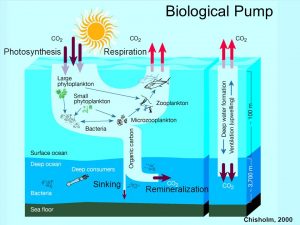Have you guys ever wondered where carbon dioxide (CO2) molecule goes after you exhale? A lot of carbon dioxide on the Earth, including what we exhale and carbon from our factories or cars, actually ends up in the ocean. Once CO2 molecule is in the ocean, it might travel in through the surface for a while before going back to the air above or it can travel deep down into the ocean and stay there for hundreds of years. A computer model was made to track CO2 in the ocean in order to find out where it travels and the time duration it stays at the bottom of the ocean. Research has shown that carbon dioxide cycles in different levels of the ocean. This information enables us to find out how the ocean responds to and contributes to global climate change.

The oceans play an important role to the Earth’s climate change because it can take in a huge amount of carbon above and store carbon in the atmosphere. In fact, more than 93% of the carbon dioxide (CO2) in the world is stored in the oceans. Fortunately, most of the CO2 is stored in the oceans, which leaves less CO2 in the atmosphere. The reason is that Greenhouse gases such as CO2 can trap heat that is radiated back to the Earth, which can overheat our planet. Thus, oceans help to store a large amount of CO2.
Tiny plants called phytoplankton live on the surface of the water where they can be exposed to sun. They gather CO2 from the atmosphere to build their bodies. When they die, phytoplankton sink into the bottom of the oceans and bacteria break them down to release the stored carbon dioxide back into the seawater. This process is called biological carbon pump, which pumps carbon dioxide into the bottom of the oceans for many years.

Study has shown that phytoplankton are usually bigger in colder areas compared to warmer areas and stick together into large clumps when they die. This will make them heavier and sink down into the ocean further and faster before they get decomposed by bacteria. The colder area of the oceans also slows down the bacteria growth, which allows phytoplankton to sink further down before their carbon dioxide be decomposed and released by bacteria.
If humans keep continuing to pollute the Earth and emit CO2 to the atmosphere, the oceans and the world will become warmer. The warm oceans can not store more CO2, which will cause CO2 to be released into the atmosphere and further heat up the Earth. In order to break this cycle, humans need to work together to save our planet and reduce the use of fossil fuels and factory waste into the atmosphere. Also, human beings can avoid many natural disasters such as hurricane, blizzard, and volcanic eruptions resulted from the effect of Global Warming.

